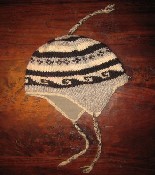#624266 - 09/27/10 12:42 AM
 Re: Diluting The Strain
[Re: ]
Re: Diluting The Strain
[Re: ]
|

Free Prostate Exams

Registered: 01/06/10
Posts: 1544
Loc: Sequim
|
[quote=Ikissmykiss]
inbred - breeding/producing CCA members as offspring
Fixed........... [/quote KK, Why do you do this? Do you think the I-net is anonymous and you have no responsibility for your words? Bad dog! Take it to the dark side. You insult me and lots of other involved CCA members who give a shite.
Edited by Doctor Rick (09/27/10 12:44 AM)
|
|
Top
|
|
|
|
#624282 - 09/27/10 01:38 AM
 Re: Diluting The Strain
[Re: Salmo g.]
Re: Diluting The Strain
[Re: Salmo g.]
|

Spawner

Registered: 05/27/08
Posts: 652
Loc: Bellingham/Socialistic Idaho
|
Big Jim,
When Chambers Creek hatchery steelhead spawn in the wild, either with themselves or mixing with wild steelhead, the resulting offspring lack sufficient fitness to survive and return as a future generation of adult fish. The number of survivors that return is statistically zero. Is that clear enough? That's why it's a bad thing when a hatchery steelhead spawns with a wild one. It removes the reproductive potential of that wild fish from the spawning population.
Sg Your example is an isolated one. In other populations hatchery fish have been shown to keep *wild* fish populations at elevated levels. In some cases hatchery fish have been successful in implementing reintroductions of extirpated populations. Granted, hatchery fish are not always capable of carrying all of the genes needed to keep populations afloat and adapt to a changing environment. FYI, the word fitness is not the correct one to use here. Fitness in ecological or biological terms applies only to the capability to produce viable offspring, not their overall success at survival.
|
|
Top
|
|
|
|
#624348 - 09/27/10 01:01 PM
 Re: Diluting The Strain
[Re: McMahon]
Re: Diluting The Strain
[Re: McMahon]
|

River Nutrients

Registered: 03/08/99
Posts: 13616
|
McMahon,
If western Washington is isolated, then yes, my example is somewhate isolated. (Those of us who deal with this issue routinely don't feel it's quite so isolated.) However, that's only in the sense that Chambers Creek hatchery steelhead are the least fit for successful reproduction (all the way through to subsequent returning adults) in the natural environment. Other hatchery steelhead strains that have been studied (typically summer runs) are also less fit in the natural environment than their wild counterparts, but they are more successful in natural reproduction than Chambers Creek fish. In the fuller context, I'm not sure that the Chambers Creek example is an isolated one; it's just the most extreme example, which makes it suitable for purposes of illustrating the point.
The lower but successful natural reproduction of summer steelhead stocks has maintained and today creates the potential for recovery of bonafide viable wild steelhead populations in systems like the Methow, Okanogan, Entiat, and Wenatchee Rivers. The same is possibly true for some Snake River tributaries too, but I've never seen the data, so I don't know.
If fitness is an incorrect term, please advise me what the correct term is. I didn't get the memo indicating that "fitness" had limited application only through the phase of producing viable offspring. Which leads me to question, how truly viable are offspring if they return as adults at a rate that is statistically near zero? Thanks.
Sg
|
|
Top
|
|
|
|
#624376 - 09/27/10 01:56 PM
 Re: Diluting The Strain
[Re: Bigjim]
Re: Diluting The Strain
[Re: Bigjim]
|

Hippie

Registered: 01/31/02
Posts: 4450
Loc: B'ham
|
I presume the reason why the offspring of the mixed stock doesn't return in viable numbers is that they are not truely bred for that system, as we see in so many rivers why hatchery fish fail at making it back in decent numbers. It is actually even a bigger deal than that (although your point about putting the wrong genes in the wrong river is valid). Even if you used the native genes from a particular river, the fish themselves are much worse off simply by the way they are raised. Check some of the more recent Oregon studies. It has been discussed on this board before.
|
|
Top
|
|
|
|
#624378 - 09/27/10 01:59 PM
 Re: Diluting The Strain
[Re: AP a.k.a. Kaiser D]
Re: Diluting The Strain
[Re: AP a.k.a. Kaiser D]
|

BUCK NASTY!!

Registered: 01/26/00
Posts: 6312
Loc: Vancouver, WA
|
I presume the reason why the offspring of the mixed stock doesn't return in viable numbers is that they are not truely bred for that system, as we see in so many rivers why hatchery fish fail at making it back in decent numbers. It is actually even a bigger deal than that (although your point about putting the wrong genes in the wrong river is valid). Even if you used the native genes from a particular river, the fish themselves are much worse off simply by the way they are raised. Check some of the more recent Oregon studies. It has been discussed on this board before. If that's so true then why is WDFW implementing it with many of our wild strains? Keith
_________________________
It's time to put the red rubber nose away, clown seasons over.
|
|
Top
|
|
|
|
#624419 - 09/27/10 03:30 PM
 Re: Diluting The Strain
[Re: stlhdr1]
Re: Diluting The Strain
[Re: stlhdr1]
|

will always be a Juvenile at Sea
Registered: 11/15/06
Posts: 677
|
I presume the reason why the offspring of the mixed stock doesn't return in viable numbers is that they are not truely bred for that system, as we see in so many rivers why hatchery fish fail at making it back in decent numbers. It is actually even a bigger deal than that (although your point about putting the wrong genes in the wrong river is valid). Even if you used the native genes from a particular river, the fish themselves are much worse off simply by the way they are raised. Check some of the more recent Oregon studies. It has been discussed on this board before. If that's so true then why is WDFW implementing it with many of our wild strains? Keith As stated before i am not a biologist, yet I think if any form of broodstocking needs to happen it should be in the form of a 4 year program where all fish that are hatchery bred are from the native strain, maximize the amount that return for four years with no retention allowed on any of them for those 4 years. All the hatchery fish will not be accepted back into the hatchery and are either forced to do their thing in the river or die at the hatchery gate( or allowed to pass the hatchery if water upstream is good. With this program i think although the fish would have been raised in a cement pond, all the unfit fish would be easily disposed in that 4 year or so period by natural means. All the hatchery fish would be native in essence(like growing condor eggs and releasing them) and the program would then shut down with a boom of wild and hatchery NATIVE strain fish. No fish would be allowed back into the hatchery (as all the hatchery native strains would be clipped, like a rear fin, not adipose) which would stop the resulting dumbing and domesticating of the hatchery fish. The only fish that would be accepted back into the program in that 4 year period would be full native fish with no clips and maybe even have them pass a dna scale test). In all aspects it seems like those fish would return as native fish, except for the original kickstarting all the subsequent returns would be native fish. 4 years or whatever a good cycle is, and shut the program down. Done and done, if it doesn't boom back then shut fishing down on that system for there is no chance for that strain to pop back in the near future. As stated before i am not a biologist, I am sure people will tell me this is a bad idea. I don't like non native strains as much as the next fanatic and want to see wild stocks return. What i want to know is WHY is this a bad idea? Why is the plan i just placed a bad idea? What is the loophole?
|
|
Top
|
|
|
|
#624420 - 09/27/10 03:36 PM
 Re: Diluting The Strain
[Re: Bigjim]
Re: Diluting The Strain
[Re: Bigjim]
|

will always be a Juvenile at Sea
Registered: 11/15/06
Posts: 677
|
Also couldn't the fish instead of being raised in cement ponds be raised in the stretch of water above the hatchery? Just by shutting down the fishery above the hatchery gate?
|
|
Top
|
|
|
|
#624442 - 09/27/10 05:05 PM
 Re: Diluting The Strain
[Re: ]
Re: Diluting The Strain
[Re: ]
|

Spawner

Registered: 08/30/10
Posts: 656
Loc: Grays Harbor
|
Okay, educate me on these numbers. How are they determining that the return rate is nearly zero? Is there a lot of genetic testing being done and they don't see any half breed fish coming back and spawning on the native spawning beds? Do they take a hatchery fish, a native fish, spawn them in the hatchery, put them through all the same routine as hatchery fish and put tags in them?
I just need to understand the methods to determine how many mix breed fish are returning. If they are taking a wild fish and a hatchery fish and spawning them in the hatchery this could skew the numbers big time. Maybe the resulting cross breed is simply stupid from all the stuff it goes through in the hatchery. Maybe the cross breed can't cope with the chemicals and such and is so weak when released that this is the cause. Do they sample large numbers of spawning fish on the spawning grounds for genetic cross breeding? Could it be just a simple case of native fish genetics being so dominant that even if they spawn with hatchery fish that it may be almost impossible to tell if it is a cross breed? Could it be that the methods that are being used to cross breed these fish is the reason they are not survivng and not that the cross breed is actually that weak?
I am not trying to be controversial, quite the contrary. I want to understand the methods that are being used to determine that this is true and fact. Should we let hatchery fish spawn with native fish, this I can't answer because I don't have the answers to these questions yet.
As for taking wild stock and raising them in the hatchery, same questions apply. Will the simple fact that these fish are being raised in a hatchery result in a geneticaly deficient fish that doesn't know how to feed itself in the wild as a fry or alvin? Can it be done where the fish are spawned and they immediately go into the wild as an alvin and must learn to fend for themselves the way a wild fish would? I have seen this done, hatchery boxes put on the side of of a stream where the eggs hatch and the alvin drop into the stream without ever being exposed to chemicals and artificial food. I don't know if it worked but I have seen it done. Maybe the overstock of hatchery fish need to be raised this way, if they don't return they don't, if they do then they should at least have a chance to spawn in the wild and their fry would have the chance to learn to feed naturaly and survive keeping the cycle going and revive wild stocks. Maybe this could be done with a small percentage of wild fish to help the eggs survive through all diversity and that could help revive wild stocks.
Lots of questions, are there answers to them or does there need to be more done to answer them? If all of this has been answered, please enlighten me, if they have not then the facts need to be re-evaluated before any such conclusion can be made about any run of fish anywhere.
If they don't know the answers then knowing them could be the means to end this debate once and for all and return both steelhead and salmon runs to historic highs instead of record lows. At the very least it would give rock solid facts based on science that works and has been tested by every means neccesary to make sure one factor isn't making the numbers look worse, or better than they really are.
_________________________
Taking my fishing poles with me to a body of water that has fish in it is not an excuse to enjoy the scenery.
|
|
Top
|
|
|
|
#624449 - 09/27/10 06:04 PM
 Re: Diluting The Strain
[Re: fish_4_all]
Re: Diluting The Strain
[Re: fish_4_all]
|

River Nutrients

Registered: 03/08/99
Posts: 13616
|
Big Jim,
The short answer is: it depends. It depends on what the fish management objective is, and it depends on the quantity and quality of available fish habitat. If you just want to recover or restore a depressed salmon or steelhead population, generally the best method is to leave them alone. Salmonid populations are extremely resilient, and they can make extreme increases in population size in one or two generations.
The exceptions are cases of extremely depressed populations and or extremely degraded habitat. In these cases, intervention with broodstocking programs can probably work. The only documented instances that I am aware of are Hood Canal summer chum and Baker Lake sockeye and coho. Steelhead broodstocking programs mostly indicate that as good or better production would have occurred by leaving the captive broodstock fish in the river to reproduce naturally.
The main reason for most intervention programs or broodstocking programs is to maintain harvest opportunity and have little or no conservation benefit, unless maintaining harvest is also considered a conservation benefit (it is under many definitions).
The issues you raise have been discussed here almost endlessly. If you search the site, you should be able to find the threads that explain the details and provide citations to the studies and conclusions and supporting evidence.
Fish 4 all,
Read the above paragraph. It's all in here, with all the gory details, but I'm not going to do the search and provide you the link. Search and learn.
Sg
|
|
Top
|
|
|
|
#624453 - 09/27/10 06:24 PM
 Re: Diluting The Strain
[Re: ]
Re: Diluting The Strain
[Re: ]
|

River Nutrients

Registered: 10/28/09
Posts: 3348
|
I've been doing my best to remove those brats from the gravel.  But therein lies a problem. As the summer wears on, some of those brats are not something I want to eat. But I still don't want to release them for the very reason of this topic. What to do? Maybe a third column on the punchcard for "funky brat tossed in the bushes"? I know this is off topic, but steelspanker's thoughts above raise an issue that interests me. When I saw a similar issue (being required to harvest steelhead from the Wenatchee that aren't exactly quality table fare) being discussed in a thread on another forum, I chimed in with a suggestion that perhaps those fish that we don't want to eat should be killed and then returned to the river. This will ensure that they can't spawn with the natives, and it will also provide valuable nutrients to the system for future generations and resident fish. It feels strange to even suggest such seemingly wasteful behavior, but I think it would be a lot less wasteful than pitching the carcass in the bushes or a dumpster.
|
|
Top
|
|
|
|
#624463 - 09/27/10 06:47 PM
 Re: Diluting The Strain
[Re: Salmo g.]
Re: Diluting The Strain
[Re: Salmo g.]
|

BUCK NASTY!!

Registered: 01/26/00
Posts: 6312
Loc: Vancouver, WA
|
Ah yes, inland steelhead quality as table fare. Although the skin color of these fish isn't chrome bright, the fish are not boots. An inland steelhead in October is packing more lipid content in its flesh than a chrome bright December Chambers Creek steelhead. That Chambers Creek fish is generally no more than four weeks from spawning, and its body has stored enough energy reserves to survive that long plus a bit extra. The inland steelhead had its last good meal in June or July and is and will survive on stored lipid reserves to spawn next March or April.
Contrary to our elitist coastal notions, those inland hatchery steelhead that we're now required to retain are perfectly good table fare, if you happen to like steelhead. So put 'em on the BBQ or smoke them and enjoy and know that they're better eating than the chrome bright steelhead you'll be bringing home in three months.
Sg And, if you get the chance to catch these precise summer fish in the Lower CR as they make their way home, you're liable to catch a bbq on fire when cooking them..... Some high fat contents!! Keith
_________________________
It's time to put the red rubber nose away, clown seasons over.
|
|
Top
|
|
|
|
#624524 - 09/27/10 10:16 PM
 Re: Diluting The Strain
[Re: stlhdr1]
Re: Diluting The Strain
[Re: stlhdr1]
|

Spawner

Registered: 08/30/10
Posts: 656
Loc: Grays Harbor
|
Well let's hope that Chambers creek is the exception and not the rule.
If I ever find the answers to all the questions I asked I will let you know.
_________________________
Taking my fishing poles with me to a body of water that has fish in it is not an excuse to enjoy the scenery.
|
|
Top
|
|
|
|
#624597 - 09/28/10 03:24 AM
 Re: Diluting The Strain
[Re: Salmo g.]
Re: Diluting The Strain
[Re: Salmo g.]
|

will always be a Juvenile at Sea
Registered: 11/15/06
Posts: 677
|
Big Jim,
Steelhead broodstocking programs mostly indicate that as good or better production would have occurred by leaving the captive broodstock fish in the river to reproduce naturally.
Sg Is this documented somewhere? The only broodstocking program I know of in Washington I am totally unsure is even ran by WDFW, and my thoughts was it was ran by guides. Yet those fish seem to be surplus on that system every year, as the numbers on that sytem for wild fish seem to be doing great, yet with an added bonus amount of fish. Now if you were to take the Skykomish( since we all like to throw that river around) not sure the numbers on it, not going to look yet i know it is going into a depressed state. Lets say the Main stem gets 1500 wild fish a year, you have the Wallace, and Reiter kick out another 500 and 300 hatchery fish respectively minus fishermens take. You raise an extra 1200 or so between wallace and reiter with non native strain fish I presume. So instead of raising those 1200 hatchery fish, if you implemented a 4 year program of broodstocking you could legitimately add a more healthy group of hatchery fish with native strain and without the retarding effects as i stated before.... which in essence would make them 1 generation hatchery fish.... not domesticated like the strains we use now. Not dumbed down and not from another basin. Now you have a viable hatchery native fish that is used to rebound stocks in a short period. So the returning numbers since it will be a local fish will be higher than current hatchery fish. Lets say we add a little on survival rate.... so now the numbers are. 1500 native wild fish - those used for broodstocking 1400 native hatchery fish for a total of near 2500 or something that ballpark after the broodstocking amount is taken out. Now for the kicker, with this plan all hatchery clipped fish are not for harvest. They are for recolonization and boom effect. Instead of 1500 natives in 4 years you would now have 2500 spawning in the mainstem, the whole program goes CNR. Now there is no hybridizing on a mass scale, its all CNR, and to top it off every system with a hatchery goes through this program in the Sound. You could literally recreate whole runs very quickly without the problems of hatchery fish. Now everyone is not flocking to the OP, instead everyone hits the local creek..... for steelheaders. Literally there is not that many steelhead fishermen compared to salmon fishermen. Me and my buddy fished the carbon about 40 to 50 times from November to February and came across maybe a handful of people in all those trips combined. 95% of fishermen want to fish for meat. I know there is a loophole here, I just don't know it. Someone point it out so I can dismiss this idea.
|
|
Top
|
|
|
|
#624618 - 09/28/10 10:36 AM
 Re: Diluting The Strain
[Re: Bigjim]
Re: Diluting The Strain
[Re: Bigjim]
|

River Nutrients
Registered: 11/25/01
Posts: 2834
Loc: Marysville
|
BigJim -
Without going into a lot of detail you proposed plan of action while interesting and at first blush sounds good it in reality would be a disaster for the wild fish and potentially the recreational fishery. These issues have been discussed here a number of times and don't know if it is productive to re-visit them.
Just a couple bullets of the issues-
Your plan does not address what is limiting the wild steelhead production in the basin. Putting more spawners on the gravel will not lead to more fish the next generation.
Impossible to avoid many of the pitfalls that make hatchery rear steelhead less productive when spawning in the wild than the naturally produced fish
Does not necessarily follow that the using wild brood stock will result in higher survival rates of the smolts.
Mining the wild fish to support such a program typically increases some of the negative hatchery/wild interactions in the spawning population leading to less productive stocks.
While if such a program was undertaken it might produce more late winter/spring fishing it would be at the cost of the early season fishery with more complex fishery management problems and higher natural produced fish impacts.
Tight lines
Curt
|
|
Top
|
|
|
|
|
|
0 registered (),
698
Guests and
3
Spiders online. |
|
Key:
Admin,
Global Mod,
Mod
|
|
11505 Members
17 Forums
73021 Topics
826133 Posts
Max Online: 3937 @ 07/19/24 03:28 AM
|
|
|















 Previous Topic
Previous Topic Index
Index

